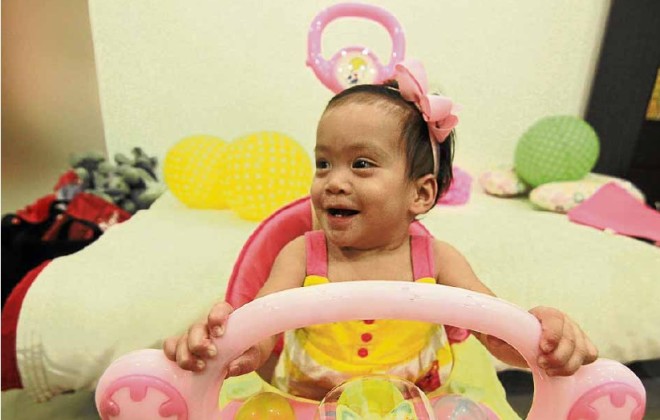Trixie was born at 28 weeks or 12 weeks earlier than her due date. At 26 weeks, when I was supposed to have an ultrasound to know my baby’s gender, my doctor said I could give birth anytime. I was given medications to control possible labor, and put on complete bed rest for 14 days.
Almost two weeks later, the doctor said my amniotic fluid was drained and that I had to undergo an emergency ceasarian section. I had no choice: I had to give birth or my baby would die.
At the delivery room, I prayed hard that my baby would be okay. After a while, I heard an infant crying. I thought it was a baby at the Neonatal Intensive Care Unit (Nicu) that was just beside the delivery room. But the anesthesiologist told me I had just given birth to a baby girl. I was too weak to cry, but felt huge relief knowing that my baby was alive.
Trixie was born weighing 1,000 grams or one kilo at 7:41 p.m., and was immediately whisked to the Nicu. I didn’t see her until the following day when I was allowed to visit. She looked so fragile and tiny and could have fitted inside a shoebox. Tubes connected to her nose helped her breathe, while a feeding tube was inserted in her mouth. Another tube was plugged into her navel for medication, another for IV fluid. Attached to her foot was a monitor to check her breathing and heart rate.
Looking at Trixie for the first time, I was overwhelmed with both love and guilt, thinking that maybe there was something I could have done, or didn’t, that triggered early labor. “I’m very sorry my baby, you don’t deserve this. I love you,” I told her.
But the doctors assured me that this was something that just happens, and there was nothing I could have done to prevent it.
I was discharged from the hospital a day after giving birth, but for the next 70 days, I was at the Nicu with Trixie. My husband Gabriel would bring me to the hospital and patiently wait, sometimes for more than three hours outside the Nicu although mothers were allowed to stay for only 20 minutes.
But I lingered to allow Trixie to feel my touch, hear my voice—to know that I was there. During those times, I would hold her, talk to her, pray, read her a story and get updates from the nurses on her condition. When it was time to go home, I would always tell Trixie to “wait for Mommy,” because I was not sure I was going to see her alive the next day.
Breast milk
We were advised to feed Trixie breast milk, the ideal nourishment needed by preemies (the term used for premature babies), that keeps them from having gastrointestinal problems. But I had very little of this, even when I tried everything to extract milk: from the traditional hilot, to taking medications, eating and drinking malunggay and other vegetables, and other ways said to help lactating mothers. I even bought an expensive electric breastpump, thinking it could help me produce the precious substance, to no avail. All I got were drops, not even enough for one feeding. There were times I broke down, asking why I couldn’t provide my baby even this one felt need.
But thanks to other lactating mothers—most of whom have become friends—we managed to feed Trixie pure breast milk for one whole month.
There were good days and bad days, and sometimes I’d go home crying. On New Year’seve, I found Trixie isolated in another room. She had acquired Pseudomonas aeruginosa, a life-threatening infection common among low birth weight infants. Trixie was given medications and several blood and platelet transfusions. Even I was not allowed to have close contact with her.
Milestone
For mothers of premature babies, every gram gained, every cubic centimeter of milk taken, and every milestone, big or small, feels like victory.
While Trixie was at the hospital, we were anxious for her to go home. But when that day finally came, we were scared we wouldn’t be able to take care of her. On Jan. 27, we came home with Trixie who, by this time, could breathe on her own and suck on her feeding bottle and weighed 750 grams heavier.
We went home with uncertainties, as Trixie had to take more than 10 medications daily. To our relief, she was no longer “a botika (pharmacy),” as her doctor described her. She had also overcome Grade 1 Germinal matrix hemorrhage that sometimes leads to hydrocephalus. We’re also hoping that her scheduled test this January would have a good result on her congenital heart defect.
In September, Trixie had to wear corrective glasses, after undergoing four laser surgeries. She had retinopathy of prematurity, a condition that has abnormal blood vessels growing aggressively in the retina that could lead to blindness. Her eye condition was bound to get worse, her doctor said, but I’m just thankful that she can see.
It’s painful to think of what Trixie had been through, but it helps to see how far she’s come. Along the way, she taught us to be strong, to fight, and keep our faith in God because miracles do happen. Many people—families and friends, and those we don’t even know—have helped us in many ways, especially with prayers. We consider them our angels here on earth. There’s a lot to be grateful for in the past year.
Trixie turns one a day before Prematurity Awareness Day. It made us realize that what happened to us has a higher purpose. I’m happy to say that my baby now serves as inspiration to parents of other preemies whom we have met.
Editor’s note: The author is an editorial assistant of the Inquirer Southern Luzon Bureau in Legazpi City.
